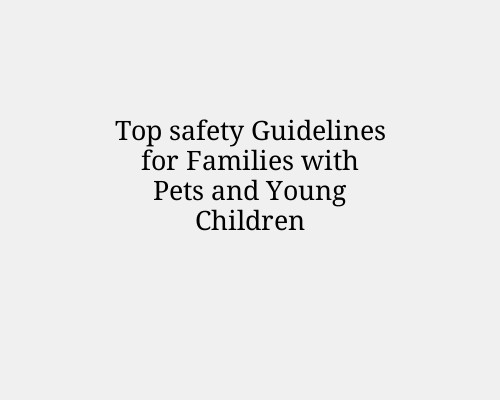
Having pets and young children under the same roof can bring tremendous joy, but it also requires a firm commitment to safety. Pets and children are naturally curious and unpredictable, and without proper precautions, even the most docile pet can react negatively under stress or provocation. To foster a safe and harmonious environment, families must proactively manage the interactions between their kids and their animal companions. The following safety guidelines are designed to help parents and caregivers protect both their children and pets.
Never Leave Young Children Unsupervised with Pets
No matter how well-trained or gentle your pet may be, never assume it's safe to leave a young child alone with them. Children may unintentionally provoke pets by pulling tails, grabbing ears, or interrupting sleep or mealtime. Supervision is critical to preventing accidental bites, scratches, or stress-related behaviours from pets.
Teach Children How to Interact with Animals
Education is the foundation of safety. Teach your children to:
Approach animals calmly and slowly. Avoid sudden movements and loud noises. Let the pet sniff them before touching.
Never hug pets tightly or place their face close to the animal’s face. Avoid disturbing pets that are eating, sleeping, or caring for their young.
Use age-appropriate language and reinforce lessons regularly through books, videos, and observation.
Create Safe Zones for Pets
Pets need a quiet retreat where they can rest undisturbed. Crates, pet beds, or separate rooms can serve as safe zones. Children should be taught to respect these areas as "off-limits." This gives pets a space to decompress and can prevent defensive aggression due to stress or overstimulation.
Understand pet body language
Recognizing signs of stress or discomfort in pets is vital. Warning signs vary by species but often include:
Dogs: lip licking, yawning, tail tucked, ears back, growling. Cats: flattened ears, twitching tail, hissing, and arched back. Birds: fluffed feathers, beak clicking, wing spreading, biting.
If a pet exhibits these behaviours, calmly separate them from the child and provide a calm space.
Keep Pet Food, Toys, and Supplies Out of Reach
Pet food, treats, and toys can pose choking hazards or cause allergies in children. Additionally, children may be tempted to play with or eat pet food, which can lead to digestive issues or bacterial exposure. Designate specific storage areas for pet items, preferably out of children’s reach.
Regular Veterinary Care and Hygiene
Healthy pets are safer pets. Ensure your animals are:
Up to date on vaccinations.
Free of parasites like fleas and ticks. Regularly groomed and bathed.
Fed species-appropriate diets.
Routine vet visits help catch health issues early. Ill pets may become irritable, increasing the risk of incidents.
Additionally, practice good hygiene:
Wash hands after petting or cleaning up after pets. Keep litter boxes, cages, and bedding clean.
Dispose of pet waste promptly and safely.
Secure All Entry and Exit Points
Pets and children are both known escape artists. Ensure all doors, gates, and windows are secure. Use baby gates to block off pet-only areas or to protect children from entering high-risk spaces like laundry rooms or garages where pet supplies may be stored.
For outdoor safety:
Keep dogs fenced in securely.
Supervise outdoor play to prevent children from wandering into areas where pets are confined, such as a dog run.
Train pets using positive reinforcement
A well-trained pet is less likely to react aggressively. Use reward-based training to teach basic commands such as “sit,” “stay,” “leave it,” and “go to your bed.” These commands are invaluable during interactions with children.
Avoid punishment-based training methods, which can increase anxiety and aggression. If you're unsure, consult a certified animal behaviourist or trainer.
Separate Pets and Children during High-Stress Situations
Certain events—such as parties, thunderstorms, or moving—can stress pets. During these times, it's wise to separate pets from children. Loud environments or excessive excitement can overwhelm animals and lead to erratic behaviour.
If your child is crying excessively, throwing tantrums, or behaving unpredictably, move them away from the pet to avoid overwhelming the animal.
Special Considerations by Species
Different pets come with specific safety concerns:
Dogs: Larger breeds may unintentionally knock over toddlers. Smaller breeds can be easily injured by rough play. Be breed-aware but remember that individual temperament matters more than size or reputation.
Cats: Scratches are common with startled or cornered cats. Keep nails trimmed and provide ample climbing and hiding spaces.
Birds: Birds can bite or peck, and their droppings can carry disease. Never allow unsupervised handling.
Reptiles and Amphibians: Salmonella risk is a serious concern. Children under five should not handle reptiles. Always wash hands after contact.
Rodents (hamsters, mice, etc.): These small animals can be dropped easily or bitten when frightened. Handle with caution.
Emergency preparedness
Prepare for the unexpected:
Keep emergency numbers (vet, poison control, paedatrician) accessible. Know basic pet and child first aid.
Have a plan for safely separating a child and pet during an incident.
Teach older children how to respond if a pet becomes aggressive—stay still, don’t scream, and slowly back away.
Encourage gentle bonding activities
Promote positive interactions such as:
Helping with feeding under supervision. Walking the dog with adult guidance.
Reading to pets.
Grooming calm animals with soft brushes.
These shared tasks can build trust, teach empathy, and strengthen the bond between your child and your pet.
Conclusion
Safety in a household with pets and young children is achievable with vigilance, education, and structured boundaries. While accidents can happen, most are preventable through proper supervision, pet training, and child education. By fostering respect and understanding between your child and your pet, you lay the foundation for a lifelong, rewarding relationship that benefits every member of the family.